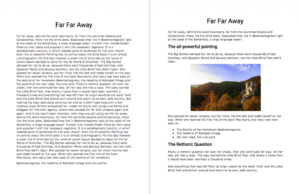Bill Gates used the phrase in an essay more than 20 years ago and content marketers have echoed it ever since: Content Is King. As a real estate professional, you know your digital marketing strategy should include high-quality, customer-focused content. Here are some ways to create content that will help your digital presence reign supreme—without the process being a royal pain.
Why You Should Care About Content
First let’s talk about some of the “why’s” of content creation. While the digital age has touched every kind of business from soup to nuts, real estate straddles real life and the virtual world. You need to cover all the bases from managing your real estate website to print and online ads to home showings and open houses.
Data shows, however, that real estate transactions are increasingly driven by technology. Online interactions often happen long before face-to-face contact between agent and customer. Neglecting the digital side of your business can damage that all-important lead pipeline.
Real Estate Happens Online
Here’s just a sampling of statistics culled from the NAR 2017 report “Real Estate in a Digital Age.”
- 72% of all homebuyers use a mobile device for their home search
- 51% of all homebuyers found the home they purchased online
- 58% of all buyers found the home they purchased on a mobile device
- 66% of first-time homebuyers are millennials, including digital natives
- 44% of all homebuyers started their home search online
- 99% of millennials search online
Your Customers Need Information Only You Can Provide
Apps and websites are the digital media people use for buying and selling homes. But you, the realtor, provide the message. And it’s a message that your customers truly need.

According to the same NAR report, “Real Estate in a Digital Age,” 52% of all homebuyers said that finding the right property was the hardest step in the homebuying process. And 44% of all homebuyers found neighborhood information “very useful.”
That’s where you and high-quality content come in.
Homebuyers want to know essential information about what a community is like. They want to know about schools, parks, things to do, traffic, commuting time, and more.
Buyers who are relocating for jobs want to know how to find the best community for their family’s needs and interests.
In today’s digital age, homebuyers are looking for this information online. And you are the expert who can provide it. Not an MLS listing. Not Zillow. You.
How You Should Create Your Content
You are the expert who can provide the information your customers want. At this point, you may be asking about keywords, SERP rankings, and SEO strategies. They all are important. But here’s an overriding piece of advice: Focus on providing high-quality content your customers will want and will use.
When content marketers say content is king, it’s because relevant, engaging, and informative content will drive traffic to your website and generate leads. Here’s how do it!
1. You Probably Didn’t Read This From Start to Finish
Most people skim and scan online content. Most readers don’t read word for word. And most don’t read in a linear way from start to end.
Developing online content is a big challenge. Content creators have to think about the needs of every kind of reader, from the skimmer to the linear reader who digests every word.
So what can you do to improve your content and increase the chances that your customers will read it? Some tried-and-true methods still apply. Others have emerged with the digital age.
2. Address Your Customers’ Needs
Make your content useful, relevant, and engaging for people–not for Google search.
Content should address a customer need. As a real estate agent, you are the person who knows your customers the best. Who are they? Millennials and GenXers looking to buy their first home? Empty nesters who want to downsize to a smaller house? Luxury home buyers or second-home buyers?
Every customer segment will have different needs, priorities, and homebuying preferences.
For example, first-time homebuyers will need to save for a downpayment and apply for a mortgage. They need to know about all the steps in the homebuying process.
You can create a first-time homebuyers’ guide like this one developed by ARC Realty. A landing page includes a dynamic form to generate leads.
Empty nesters need to sell their current home before or after moving into a downsized home. They also must come up with an answer to the big question of where to downsize.
Peabody and Smith Realty created this downsizing guide for would-be downsizers in New Hampshire.
3. Create an Engaging Headline
Good headlines increase traffic and improve search results. Here’s a great tool to help you: CoSchedule has a free headline analyzer that rates your headline on total length, number of words, and use of power words. The headline for this post scored 75!
4. Chunk Up the Content
Online content should be structured. Chunk it up with standalone heads, run-in heads, bullets, and lists. These elements organize content, which reduces content fatigue and fits the way online readers read.
Many readers will skim headings and then decide if they want to read further. Good headings are like signposts that give your readers a path to follow.

5. Add Images
Images make content more readable in a number of ways.
First, they break up large chunks of content, which in itself increases readability. More importantly, images convey content. Never choose images for purely illustrative reasons.
An image is an opportunity to convey content visually. Keep in mind that many people are visual learners. Content-rich images will meet your customers’ needs.
You can search for no-cost, copyright-free, no-attribution-needed images on these sites:
- Pixabay.com https://pixabay.com/
- Pexels.com https://www.pexels.com
- Librestock http://librestock.com
Flickr is another terrific, no-cost source for Images. But they do require attribution. Look for licenses that allow for commercial use and follow the rules for attributing them. It’s easy to do. One advantage of Flickr is that you can search for specific locations and places, which is important for a real estate company.
6. Keep Paragraphs Short
Many of us were taught that a paragraph consists of at least five sentences: a topic sentence, three supporting details, and a conclusion or transition.
A paragraph of five sentences, however, looks much longer on a smartphone. To many readers, longer text = more time to read = skippable content.
I am here to tell you that one-sentence paragraphs are absolutely OK.
See what I did there? Writers use one-sentence paragraphs all the time. You should, too.
7. Avoid Big Blocks of Text
Publishers, editors, and graphic designers have known this for ages. Large blocks of text are harder to read and easier to skip. Break things up with images and infographics.
Did you make it to the end of this post? Congratulations!
Content may be king, but the real power behind the throne are your customers. Give them the royal treatment they deserve by using these tips and strategies when you create content.
